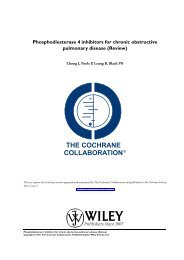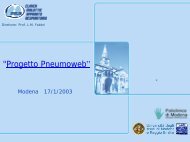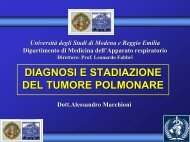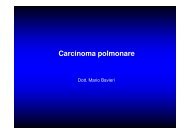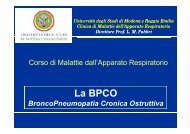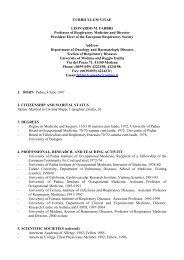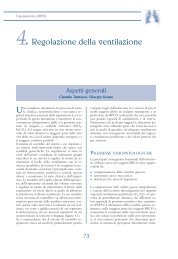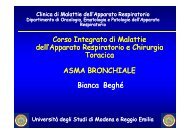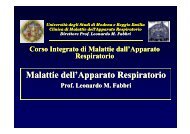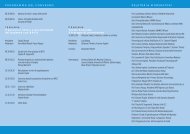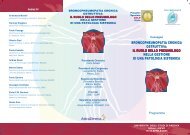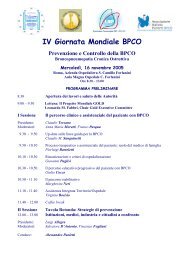5.Riacutizzazioni delle BPCO - Clinica malattie apparato respiratorio
5.Riacutizzazioni delle BPCO - Clinica malattie apparato respiratorio
5.Riacutizzazioni delle BPCO - Clinica malattie apparato respiratorio
You also want an ePaper? Increase the reach of your titles
YUMPU automatically turns print PDFs into web optimized ePapers that Google loves.
5. RIACUTIZZAZIONI DELLE <strong>BPCO</strong><br />
corciare la durata <strong>delle</strong> riacutizzazioni, anche se<br />
possono migliorare i sintomi 8 .Nonostante ciò,questi<br />
farmaci sono ampiamente utilizzati, anche se talora<br />
possono determinare un’eccessiva mobilizzazione<br />
<strong>delle</strong> secrezioni.<br />
Il ruolo della fisioterapia nelle riacutizzazioni della<br />
<strong>BPCO</strong> non è stato adeguatamente studiato 8 .Tali<br />
tecniche possono comunque essere utili per facilitare<br />
la rimozione <strong>delle</strong> secrezioni e per migliorare<br />
la funzione dei muscoli respiratori, oltre che<br />
per favorire una precoce mobilizzazione 38 .<br />
Inibitori dell’anidrasi carbonica, come l’acetazolamide,<br />
sono stati utilizzati come acidificanti, con<br />
conseguente riduzione dei bicarbonati, aumento<br />
del drive ventilatorio, riduzione della PCO 2 e aumento<br />
della PO 2 . Alcuni studi hanno confermato<br />
ciò 39 .Tuttavia, non è noto se tali variazioni fisiologiche<br />
siano associate a benefici clinici.<br />
Prevenzione<br />
e trattamento <strong>delle</strong> complicanze<br />
Un’elevata incidenza di emorragia gastrointestinale<br />
è stata riportata nei pazienti con insufficienza<br />
respiratoria acuta. Per prevenire tale evenienza, è<br />
consigliabile la somministrazione di sucralfato e<br />
ranitidina.<br />
Le aritmie sopraventricolari e ventricolari sono<br />
frequenti nei pazienti con <strong>BPCO</strong> riacutizzata. La<br />
causa è multifattoriale: ipossiemia, acidosi, alterazioni<br />
elettrolitiche (ipopotassiemia, ipomagnesiemia),<br />
uso di teofillina o di alte dosi di beta2-agonisti,<br />
cardiopatie associate. È consigliabile uno<br />
stretto monitoraggio elettrocardiografico, pronta<br />
correzione <strong>delle</strong> cause e adeguato trattamento farmacologico.<br />
BIBLIOGRAFIA<br />
1. National Institute of Health: GOLD: Global strategy<br />
for the diagnosis, management, and prevention<br />
of chronic obstructive pulmonary disease. NHL-<br />
BI/WHO Workshop report, NIH publication No.<br />
2701, april 2001.<br />
2. Anthonisen NR, Manfreda J, Warren CPW et al:<br />
Antibiotic therapy in exacerbations of chronic obstructive<br />
pulmonary disease. Ann Inter Med 1987;<br />
106:196-204.<br />
3. Seemungal TAR, Donaldson GC, Bohwmik A et al:<br />
Time course and recovery of exacerbations in patients<br />
with chronic obstructive pulmonary disease.<br />
Am J Respir Crit Care Med 2000; 161:1608-1613.<br />
4. Connors AF, Dawson NV,Thomas C et al: Outcomes<br />
following acute exacerbation of severe chronic<br />
obstructive lung disease.Am J Respir Crit Care Med<br />
1996; 154:959-867.<br />
5. Emerman CL, Lukens TW, Effron D: Physician estimation<br />
of FEV 1 in acute exacerbation of COPD.<br />
Chest 1994; 105:1709-1712.<br />
6. ERS Consensus Statement: Optimal assessment and<br />
management of chronic obstructive pulmonary disease<br />
(COPD). Eur Respir J 1995; 8:1398-1420.<br />
7. British Thoracic Society: Guidelines for the management<br />
of chronic obstructive pulmonary disease.<br />
Thorax 1997; 52(Suppl.5):S1-S28.<br />
8. Bach PB, Brown C, Gelfand SE et al: Management<br />
of acute exacerbations of chronic obstructive pulmonary<br />
disease: a summary and appraisal of published<br />
evidence.Ann Intern Med 2001; 134:600-620.<br />
9. Kuhl Da,Agiri AO, Mauro LS: Beta-agonists in the<br />
treatment of acute exacerbations of chronic obstructive<br />
pulmonary disease. Ann Pharmacoter<br />
1994; 28:1379-1388.<br />
10. Turner MO, Patel A, Ginsburg S et al: Bronchodilator<br />
delivery in acute airflow obstruction.A metaanalysis.<br />
Arch Intern Med 1997; 157:1736-1744.<br />
11. Karpel JP, Persin J, Grenderg D et al:A comparison<br />
of the effects of ipratropium bromide and metaproterenol<br />
sulfate in acute exacerbations of COPD.<br />
Chest 1990; 98:835-839.<br />
12. Shrestha M, O’Brien T, Haddox R et al: Decreased<br />
duration of emergency department treatment<br />
of chronic obstructive pulmonary disease exacerbations<br />
with the addition of ipratropium bromide<br />
to beta-agonist therapy. Ann Emerg Med 1991;<br />
20:1206-1209.<br />
13. Rebuck AS, Chapman KR, Abboud R et al: Nebulized<br />
anticholinergic and sympathomimetic treatment<br />
of asthma and chronic obstructive airway disease in<br />
the emergency room. Am J Med 1987; 82:59-64.<br />
14. Patrick DM, Dales RE, Stark RM et al: Severe exacerbations<br />
of COPD and asthma. Incremental benefit<br />
of adding ipratropium to usual therapy. Chest<br />
1990; 98:295-297.<br />
15. Rice KL, Leatherman JW, Duane PG et al: Aminophylline<br />
for acute exacerbations of chronic obstructive<br />
pulmonary disease.Ann Intern Med 1987;<br />
107:305-309.<br />
16. Murata GH, Gorby MS, Chick TW et al: Aminophyllin<br />
in the outpatient management of decompensated<br />
chronic obstructive pulmonary disease.<br />
Chest 1990; 98:1346-1360.<br />
107



